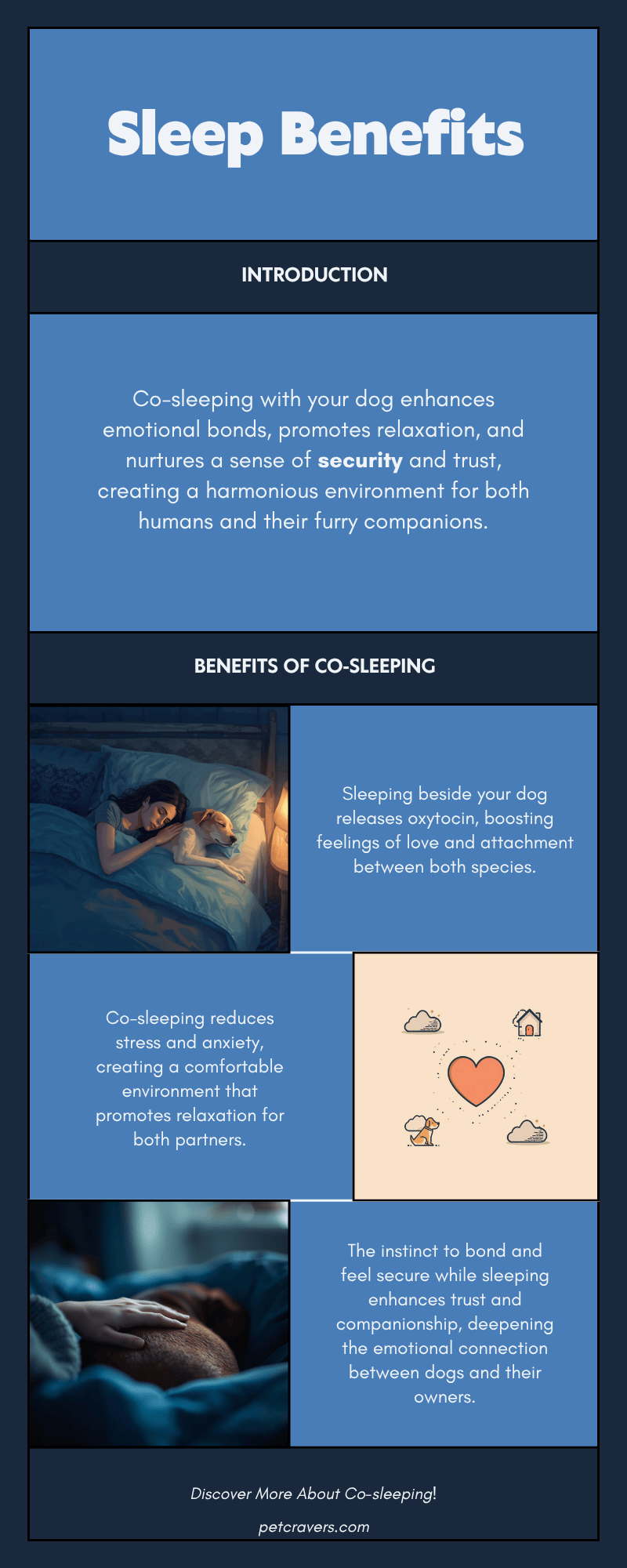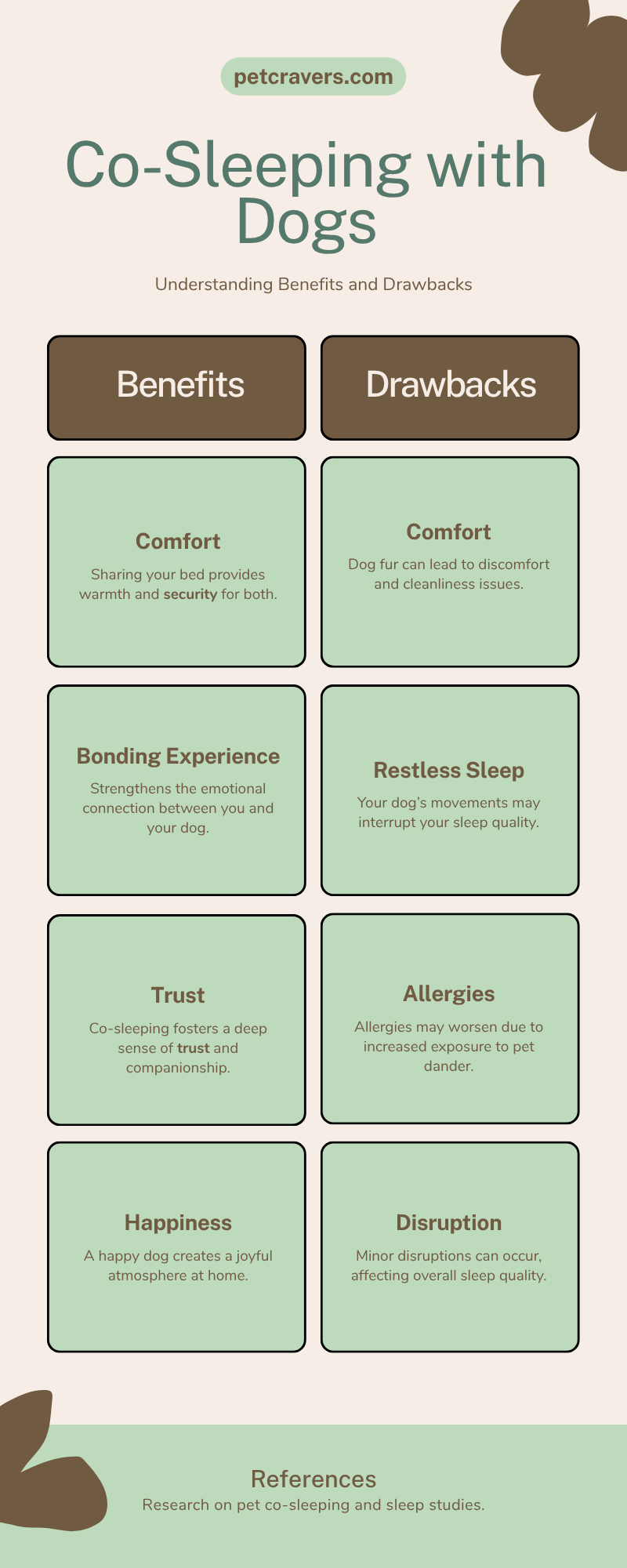Introduction
For many dog owners, the end of the day is not complete without sharing a cozy spot in bed with their furry companion. Sleeping with your dog is a common practice that provides comfort, warmth, and a sense of companionship. Beyond the immediate emotional satisfaction, this simple act can have a significant impact on the bond between you and your dog.
Dogs are naturally social animals, and their instincts often drive them to seek proximity to members of their “pack.” Sharing a bed allows your dog to feel safe, secure, and closely connected to you. At the same time, humans often experience a sense of reassurance and emotional comfort when their canine companions are nearby during the night.
In this post, we’ll explore how sleeping with your dog can strengthen your bond, the benefits and potential drawbacks, signs your dog enjoys bedtime cuddles, and practical tips for co-sleeping in a healthy, safe, and mutually enjoyable way. Understanding these dynamics can help you make informed decisions and create a bedtime routine that enhances trust, attachment, and overall well-being for both you and your dog.
The Science of Co-Sleeping with Dogs
Sleeping with your dog isn’t just a cozy habit—it also has roots in science and instinct. Understanding how co-sleeping affects both dogs and humans can shed light on why this practice strengthens your bond.

1. How Dogs Perceive Sleeping Arrangements
Dogs are pack animals by nature. In the wild, they often sleep close to their pack members for safety, warmth, and social bonding. When your dog sleeps beside you, they are following these natural instincts, feeling secure and connected to their trusted human pack member.
2. Canine Instincts and Social Bonding During Rest
During sleep, dogs remain partially alert to their surroundings. Being near you allows them to monitor and protect their pack, reinforcing feelings of attachment and loyalty. This closeness helps solidify the bond by combining comfort with instinctual reassurance.
3. Effects on Human Sleep: Emotional and Physiological Perspectives
Humans also benefit from co-sleeping with dogs. Physical presence can reduce stress and anxiety, lower heart rate, and even trigger the release of oxytocin, the “bonding hormone,” in both humans and dogs. This hormonal exchange promotes feelings of trust, love, and security, creating a mutually beneficial cycle of emotional connection.
4. Reinforcement of Positive Associations
When your dog associates bedtime with comfort, safety, and closeness, they are more likely to seek companionship in positive ways throughout the day. This reinforces daily interactions, strengthens emotional attachment, and enhances overall well-being.
By understanding the science behind co-sleeping, it becomes clear that sharing your bed is more than a habit—it’s a way to nurture trust, security, and emotional bonding between you and your dog.
Benefits of Sleeping with Your Dog
Sleeping with your dog can offer numerous benefits that go beyond warmth and companionship. When done thoughtfully, co-sleeping can enhance emotional connection, reinforce trust, and create a sense of security for both you and your furry friend.
1. Emotional Comfort and Security
Having your dog nearby at night provides a calming presence, reducing feelings of loneliness and anxiety. For humans, this closeness can be soothing after a long day, while for dogs, it signals safety and reassurance. The mutual comfort strengthens the emotional bond between you and your pet.
2. Strengthening the Human-Dog Bond
Physical proximity during sleep promotes the release of oxytocin, often called the “love hormone,” in both humans and dogs. This hormone fosters trust, attachment, and a sense of companionship, making your relationship with your dog more emotionally fulfilling.
3. Improved Routine and Consistency
Sharing a sleeping space helps create predictable routines, reinforcing positive habits and a sense of stability. Dogs thrive on consistency, and sleeping together can become a comforting ritual that enhances daily interactions.
4. Reinforcement of Trust and Safety
By allowing your dog to sleep close to you, you signal that they are valued and protected. This reinforces trust and can help dogs feel secure in their environment, which translates into calmer, more confident behavior during the day.
5. Encouraging Positive Daytime Behavior
The closeness and reassurance gained during nighttime can carry over into daytime interactions. Dogs that feel secure and connected at night are often more affectionate, obedient, and socially balanced during the day.
By recognizing these benefits, it’s clear that co-sleeping can do more than provide comfort—it can actively strengthen the emotional bond and trust between you and your dog.
Potential Drawbacks or Considerations
While sleeping with your dog can strengthen your bond, it’s important to consider potential challenges to ensure both you and your pet enjoy a healthy, restful sleep.

1. Sleep Disturbances
Dogs may move around, snore, or wake up during the night to go outside. This can interrupt your sleep, leading to fatigue or discomfort. Light sleepers may find co-sleeping challenging, especially with larger or highly active dogs.
2. Allergies or Hygiene Issues
Pet dander, shedding fur, and outdoor dirt can trigger allergies or respiratory issues in sensitive individuals. Maintaining a clean sleeping area and grooming your dog regularly is essential to minimize these risks.
3. Behavioral Implications
Some dogs may develop dependency or possessiveness over the bed. In certain cases, this could lead to behavioral challenges, including difficulty being separated from you or resource guarding. Clear boundaries and training are key.
4. Safety Concerns
Small dogs, puppies, or elderly owners may face accidental injuries if the dog rolls over or jumps on and off the bed. Ensuring safe sleeping arrangements, such as ramps or designated areas, can help prevent accidents.
5. Impact on Daily Routine
If your dog becomes too accustomed to sleeping in bed, it may be harder to transition them to their own space when needed. Establishing optional sleeping areas early can provide flexibility.
By being aware of these potential drawbacks, you can make informed decisions about co-sleeping and implement strategies that maximize comfort and safety for both you and your dog.
Signs Your Dog Enjoys Sleeping with You
Not all dogs will express enjoyment in the same way, but several cues indicate that your furry friend feels comfortable and happy sharing your bed. Recognizing these signs helps ensure co-sleeping is a positive experience for both of you.
1. Relaxed Posture and Comfort
A dog that curls up calmly or stretches out near you is showing that they feel secure and at ease. Relaxed muscles and soft breathing are clear indicators of comfort.
2. Gentle Nudging or Curling Up Close
Dogs often nudge your hand, arm, or body before settling down, or curl up against you as a sign of trust and affection. This behavior shows they seek closeness and companionship.
3. Calm Breathing and Minimal Movement
A dog that sleeps soundly without frequent tossing or restlessness is likely comfortable with their surroundings and feels safe near you.
4. Tail Wagging or Seeking Closeness Before Sleep
Some dogs will wag their tails, paw gently, or climb onto the bed before bedtime, signaling anticipation and enjoyment of the shared sleeping experience.
5. Staying Nearby Even When Waking
Dogs that return to your side if they wake during the night demonstrate that they value your presence and security, reinforcing the bond between you.
Observing these signs ensures that co-sleeping is mutually enjoyable, promoting a trusting, affectionate, and secure relationship with your dog.
Tips for Healthy Co-Sleeping
Sleeping with your dog can be rewarding, but creating a safe and comfortable environment is essential for both you and your pet. Here are practical tips for healthy co-sleeping:

1. Set Boundaries and Designated Spaces
Allow your dog to choose their spot on the bed, but maintain clear boundaries to prevent possessiveness. Use a blanket or designated area so they understand where they can and cannot lie.
2. Encourage Their Own Bed or Blanket
Even if your dog sleeps with you, providing a separate bed or blanket helps them feel secure independently. This also allows flexibility when co-sleeping isn’t possible.
3. Maintain Hygiene
Regular grooming and washing bedding minimize allergens, dirt, and odors. Clean paws and fur before bedtime to keep the sleeping area sanitary for both you and your dog.
4. Create a Calming Bedtime Routine
Establish a predictable nighttime routine, including feeding, bathroom breaks, and a calm pre-sleep activity. Dogs thrive on consistency, which enhances relaxation and sleep quality.
5. Monitor Temperature and Comfort
Ensure the sleeping environment is comfortable and safe, avoiding overcrowding or excessive heat. Adjust blankets or pillows to accommodate both human and canine comfort.
6. Observe and Adapt
Watch your dog’s behavior during co-sleeping. If they seem restless, anxious, or uncomfortable, adjust arrangements accordingly to ensure the experience is positive for both of you.
By following these tips, you can make co-sleeping enjoyable, safe, and bonding-focused, strengthening your relationship while promoting restful sleep.
When to Avoid Co-Sleeping
While sleeping with your dog can strengthen your bond, there are situations where it may not be appropriate. Recognizing these scenarios ensures the well-being of both you and your pet.
1. Dogs with Behavioral Problems or Aggression
If your dog shows signs of aggression, possessiveness, or resource guarding, co-sleeping may exacerbate these behaviors. In such cases, it’s safer to provide a separate sleeping area until the behavior is managed through training.
2. Human Sleep Disorders
Light sleepers, those with insomnia, or individuals affected by snoring may experience disturbed sleep due to a dog’s movement at night. Ensuring both parties get adequate rest is important for health and safety.
3. Allergies or Respiratory Issues
People with allergies, asthma, or other respiratory concerns may need to avoid sharing a bed to prevent triggering symptoms. Proper grooming, air purifiers, and designated sleeping spaces can help mitigate risks.
4. Puppies or Very Small Dogs
Sleeping with tiny or fragile dogs carries accidental injury risks, such as rolling over or being squished. Special care, ramps, or separate beds are recommended for their safety.
5. Elderly or Mobility-Challenged Owners
Owners with limited mobility or balance issues should avoid potential falls or injuries caused by a dog jumping on or off the bed.
By understanding these situations, you can make informed decisions about co-sleeping, ensuring it remains a safe and positive bonding experience.
Conclusion
Sleeping with your dog can be a deeply rewarding experience, offering warmth, comfort, and a unique opportunity to strengthen your bond. From the instinctual sense of security your dog gains to the emotional reassurance you experience, co-sleeping fosters trust, attachment, and companionship.
However, it’s important to approach co-sleeping thoughtfully. Observing your dog’s behavior, setting clear boundaries, maintaining hygiene, and considering individual health or behavioral factors ensures that the experience is safe, positive, and mutually enjoyable.
When done mindfully, sharing a bed with your dog can transform bedtime into a daily ritual of connection. It strengthens emotional ties, reinforces trust, and provides both dogs and owners with a sense of security and well-being. Ultimately, co-sleeping is more than just sharing space—it’s a powerful way to nurture love, comfort, and closeness in your relationship with your canine companion.




Leave a Reply